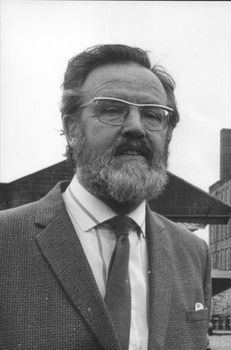Stuart Feather Lithics Collection
Keith Boughey, 2020. https://doi.org/10.5284/1062846. How to cite using this DOI
Data copyright © Keith Boughey unless otherwise stated
This work is licensed under a Creative Commons Attribution 4.0 International License.
Primary contact
Keith
Boughey
Church Bank
Church Hill
Hall Cliffe
Baildon, W. Yorks
BD17 6NE
Resource identifiers
- ADS Collection: 3523
- DOI:https://doi.org/10.5284/1062846
- How to cite using this DOI
Introduction

Stuart Wharton Feather (1927-2002) was born in Keighley, West Yorkshire and lived there for the whole of his life. During the 1950s he worked part-time for the Ordnance Survey as an unpaid recorder, plotting onto 6in:mile maps every archaeological or historical site and find-spot for miles in and around the Keighley area - maps which still provide a rich and invaluable source of information for anyone wishing to make a serious study of any period in the area. In 1965 he was appointed Assistant Keeper at the then Cartwright Hall Museum, Bradford, West Yorkshire. During this time, as a member of the Cartwright Hall Archaeology Group, he developed a great interest in the so-called 'cup-and-ring marked' rocks of the district and subsequently went on to search large areas of the north of England, discovering many previously unknown carved rocks on the uplands of the Wharfe and Aire valleys, in County Durham, and was the first to recognise their presence on the North York Moors.
Feather also made an impressive collection of Neolithic stone axe rough-outs from most of the major axe-factories in the British Isles: Langdale in Cumbria, Mynnyd Rhiw and Gareg Fawr in N. Wales, and Tievebulliagh in N. Ireland. He was also an avid and long-term collector of prehistoric flint tools and waste, much of it from the local moors around Keighley, in particular on Oxenhope Moor, where he recognised several new Mesolithic sites or ‘workshops’. Even more impressively, he collected huge quantities of Mesolithic flint tools, flakes and waste off the Carrs south of Scarborough, including from around the famous Mesolithic site of Star Carr, and alone gathered together the largest single collection of Mesolithic flint axes (13 axes in all, mostly of the characteristic tranchet type) to have been found in the area.
In 1970, when Bradford Metropolitan District Council decided they should have an Industrial Museum, Feather was put in charge of setting-up the Museum. The Museum officially opened in 1974 with Feather as its first Curator until his early retirement due to ill health in 1985.
Except for his research into cup-and-ring marked rocks, little of this work was ever published. Shortly after his death, the applicant made contact with his widow, who kindly agreed to make his entire private collection of archaeological material still stored at the family home in Keighley available for cataloguing and research - hence the digital archive. The applicant feels that the lithics collection and the list of sites and finds especially deserve to be brought to the attention of both the archaeological community as well as the wider public. Accordingly, the current archive contains a miscellany of files covering his extensive diaries, in which he noted all the details of his discoveries, including locations, a complete database of the same, as well as databases and images of both his lithics collection and axe roughouts.
The deposition of this archive was funded by the Yorkshire Archaeological & Historical Society and the Open Access Archaeology Fund.





